Affiliate disclosure: This post may contain affiliate links. Please see our Privacy Policy.
Shagbark hickory syrup is a delicious bonus harvested from hickory trees. While they already produce incredibly tasty hickory nuts in the fall, you can also make hickory syrup for year-round harvest.
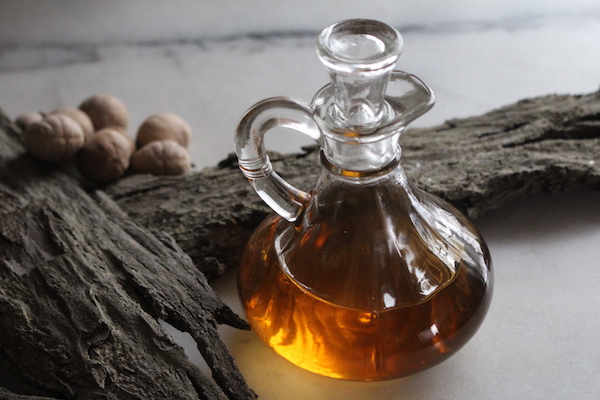
Living in Vermont, tapping trees for syrup is a yearly ritual. We already make maple syrup in the late winter, and we’re even hoping to make a profit from our backyard maple operation someday.
After maple, we tap birch trees for distinctive birch syrup, and we also make ironwood syrup for a rare treat.
In fact, there are around 30 tree species that can be tapped for syrup (besides just sugar maples). When I started doing the research I learned that you can tap beech trees and black walnuts, but shagbark hickories are a bit different.
Shagbark hickory syrup isn’t made by tapping the trees like other tree syrups, it’s actually made from the bark. The bark is used to flavor a really unique syrup, which means you don’t need any specialized tree tapping equipment.
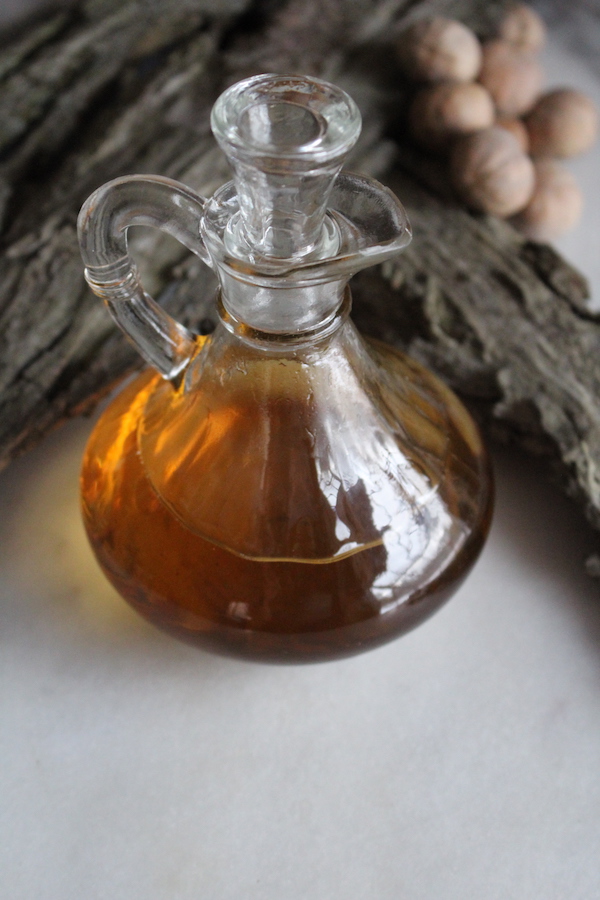
Shagbark hickory trees naturally shed their bark, and it peels off in plates as the tree grows. You can often find shed bark around the trunk of a shagbark just waiting for the harvest.
I’d been looking for shagbark hickory trees for years, and when I finally found a stand of more than 50 of them this year, it was just past the nut harvest. I could see squirrels packing in the last few kernels on the forest floor, but the trees had another gift to give…
Harvesting Bark from Shagbark Hickory Trees
A couple of things to note about harvesting shagbark hickory bark…
Be Gentle! Shagbarks are very slow-growing trees. They won’t produce nuts until they’re 40-80 years old, and at that point, their trunk may only be about 4 inches across. If you injure these trees, you’re leaving a mark that will last generations.
Harvest bark that’s already detached from the tree, by breaking off the hanging pieces. Don’t disturb the attachment point, just break the bark that’s already out there flapping in the wind.
It’s better for the tree, and it’s actually better for your shagbark syrup. The bark needs to be dried before it’s used anyway, and the hanging pieces are already partway there. It’s important to get the bark dried quickly, as wet bark will actually start to mold in storage if you’re not making syrup right away.
It doesn’t take all that much bark to make the syrup. Yields vary, but I made about 6 cups of syrup from 1 pound of bark (literally just a few pieces).
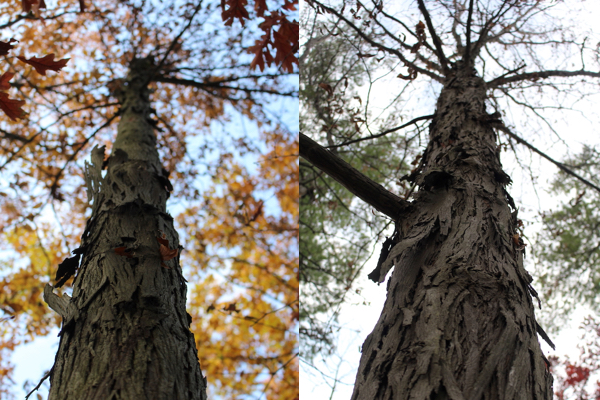
How to Make Shagbark Hickory Syrup
Once you’ve brought the hickory bark home, the next step is toasting. Toasting ensures that the bark is totally dried, as it may mold if you’re storing it for a while before making the syrup. Get to toasting it right away, even if you don’t want to make syrup yet.
Toasting also really enhances the flavor of the bark, and you’ll smell it as it’s cooking. The whole house will smell like vanilla, maple and toasted nuts.
Break the bark into manageable pieces, trying to increase their surface area as much as possible (but not pulverizing them). Think a couple of inches long, by 1-2 inches wide.
Next, bake the bark pieces for about 20 minutes at 350 degrees. The actual cooking time may vary a bit since bark pieces might be thicker, wetter or just bigger than the ones I used.
Let your nose tell you when they’re done. The pieces should be really fragrant, and just ever so slightly darkened on the surface.
Once the bark is toasted, you can store it for later use or make the syrup immediately.
Place the toasted bark into a saucepan and fill the pan with enough water to just cover the bark. I used a small saucepan with 1/2 pound of bark, and it took about 4 cups of water to cover it completely.
Bring the pan to a low simmer, and slowly cook the bark for 30-45 minutes. Keep the heat low, as boiling it hard will make a bitter syrup.
At that point, strain and measure the hickory tea you’ve created. In my case, I started with 4 cups and was down to 2 cups at straining.
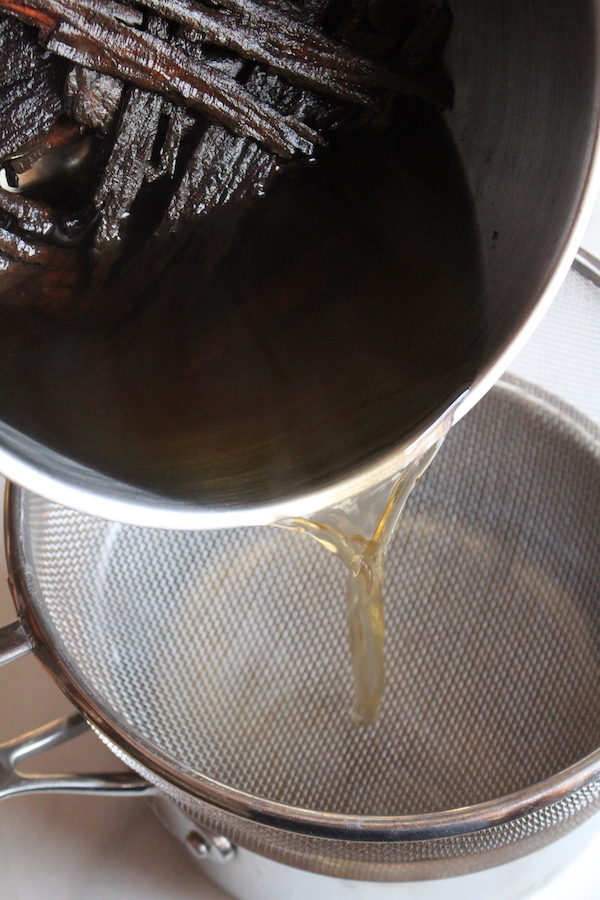
For every cup of strained hickory bark tea, add 1 cup of sugar. This one to one ratio will let you start at a simple syrup, which will allow the finished hickory syrup to come together pretty quickly.
Hickory Syrup Finish Temperature
There’s a bit of debate about the finish temperature for hickory syrup. Many sites will tell you to cook to 225 degrees F, but then those same sites give you all sorts of advice on how to deal with crystallization issues…
We’ve been making tree syrups for a long time, so I’ll add my two cents…
Maple syrup, which is mostly glucose, finishes at 219.5 degrees F at sea level. At higher elevations, it finishes at a lower temperature. Here on our homestead, at about 1000 feet above sea level, we finish our maple syrup at 217.5 (the temp drops by about 1 degree for every 500 ft in elevation rise).
Birch syrup, which is mostly fructose, finishes at 225 degrees (or 223 here at 1000 feet elevation).
I’m using pure cane sugar for my hickory syrup, so the finish temperature should be the same as maple syrup.
Ironically, the same sites that tell you 225 also tell you to add a bit of corn syrup (ie. fructose) to help prevent crystallization. I’m guessing that they’re just following some old instruction from someone at some point that actually made the syrup with corn syrup, and that same piece of information has just been perpetuated for a long time.
Thread stage for candy making is at 230 to 235, so if you’re cooking regular cane sugar to 225, you’re awfully close to making candy instead of syrup. No wonder it’s crystallizing.
I watched this syrup cook, and when it looked “done” to my syrup-making eye, I checked it with the thermometer. Sure enough, it said 217. Pretty darn close to textbook.
Hickory Syrup Yield
The total yield is obviously going to vary based on your stove, the size of your bark pieces and how you cook it. Adding “enough water to cover the bark” isn’t exactly an exact measurement.
That said, I did a batch with 1/2 pound of bark pieces (weighed before drying/toasting). It took 4 cups of water to cover them. After simmering, I had 2 cups water. I added 2 cups sugar.
My total yield was exactly 3 cups.
From that, you can estimate a yield of roughly 6 cups of shagbark hickory syrup from every pound of bark collected.
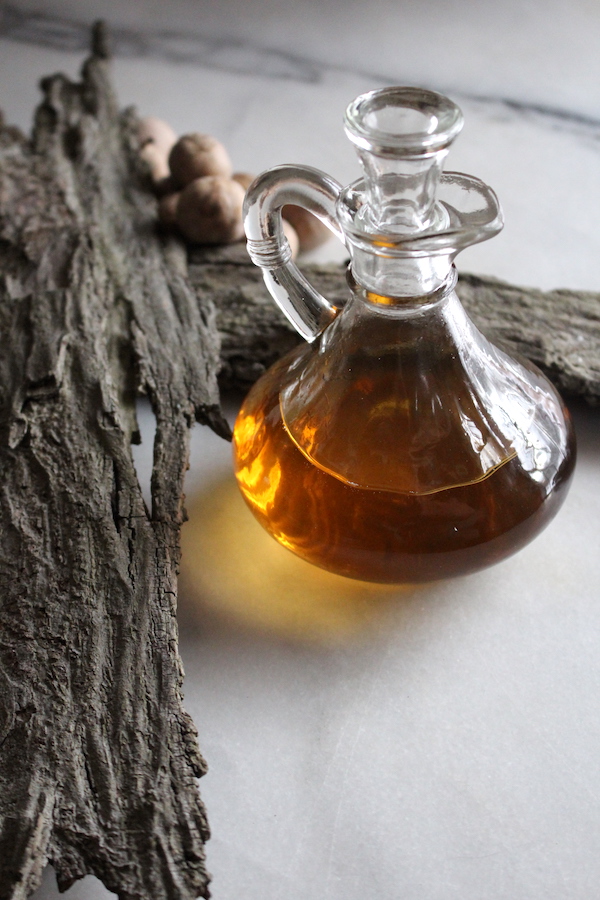
Storing Hickory Syrup
Hickory syrup, like maple syrup, will mold on the surface if left at room temperature in an unsealed container. Keep the open bottle that you’re actively using in the refrigerator, and can up the rest in mason jars.
The process for hickory syrup is the exact same as canning maple syrup for long-term preservation, and it’s not really “canning” by a strict sense of the word. It’s not like making a jam with a water bath canner, it’s really simple.
Just pour the hot syrup into clean, dry jars leaving as little headspace as possible (about 1/4 inch). Seal the jars with 2 part canning lids and wait for them to suction shut.
How to Use Hickory Syrup
The hickory syrup can be used in all the same ways you use maple syrup. It tastes similar, but not the same. Hickory syrup has notes of vanilla and a bit of toasted nuttiness. Really, it’s quite different, and you’ve got to taste it to know.
Happy syrup making!
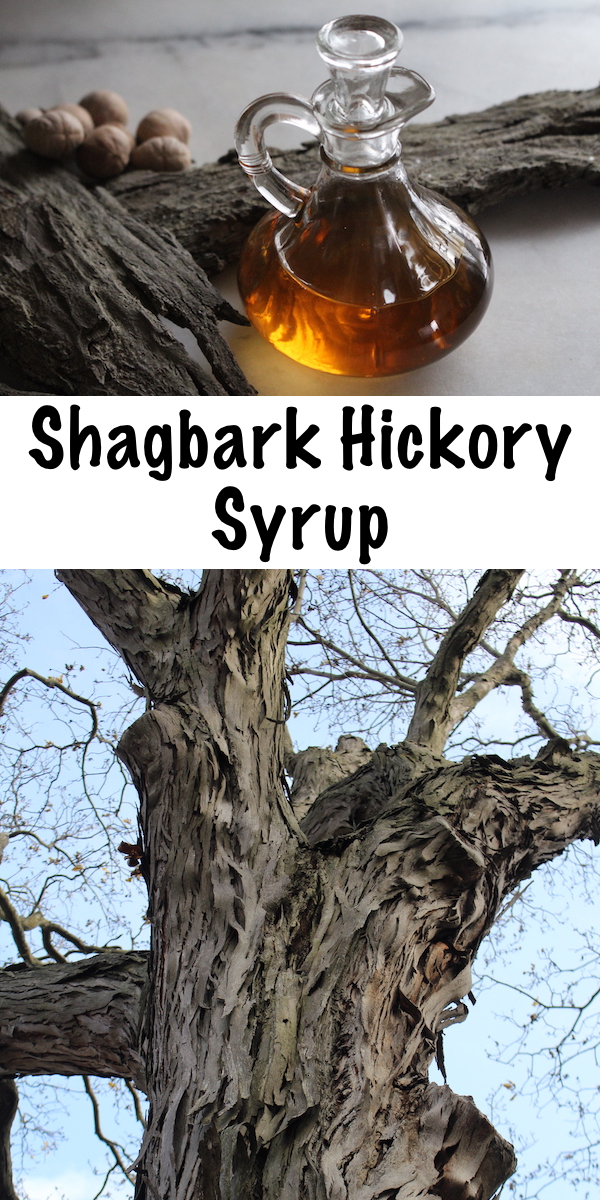
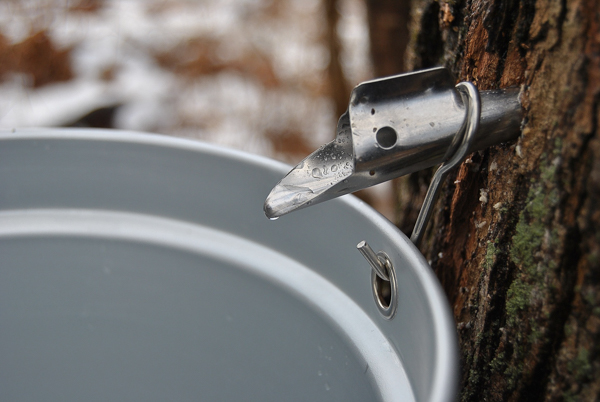
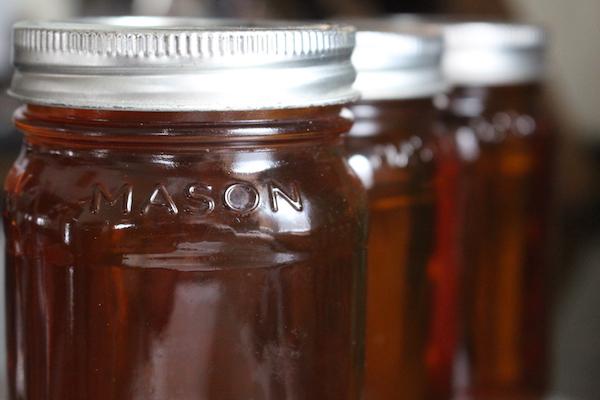
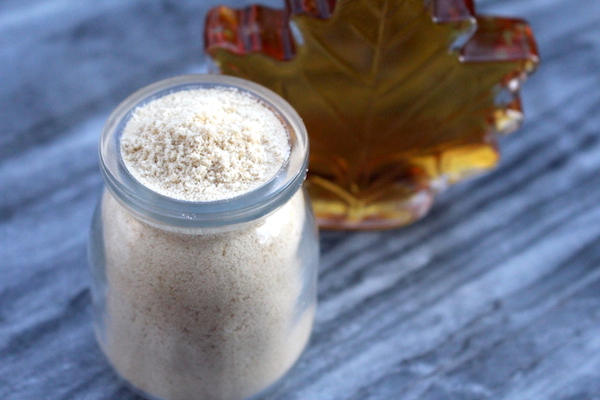
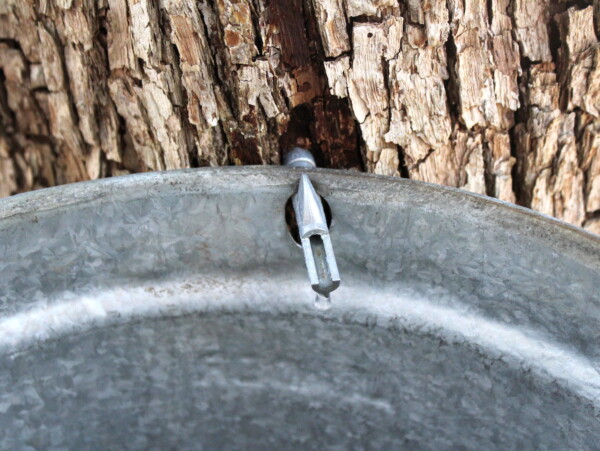
What are your thoughts in using honey instead of white sugar?
I am new to this off grid living but loving it, just me and my 2 dogs on the side of the mountain.
Yup, honey will work just fine. I’d use a mild flavored honey so you can still taste the hickory flavor, but it’ll be delicious I’m sure. Enjoy! *waves from my side of the mountain here in Vermont*
We have several shag barks on our property but the bark always has a little bit of green lichen on it. How do I find pieces that are clean?
Some people say that you can scrub it off. You may want to try that and see if it works.
Hi Ashley,
Your blog, IG and newsletters are my new favorite! They are so very informative. I’m learning a lot from each post. My question: my shagbark hickory’s bark appears to be covered in a thin layer of lichens. Can I scrape this off before toasting, and still use it for syrup? Or should I leave well enough alone? Thanks for any guidance you can provide!
Lynn
It’s best to find bark without lichens as it can cause a bitter flavor in the syrup.
can i use any hickory for this or does it have to be this kind thanks
To the best of my knowledge it needs to be shagbark hickory. I’ve never tried the others, but I’m not sure they’d work the same.
Made our first batch two weekends ago, Came out great, smooth nutty flavor. Just guest on how far to reduce the tea done letting it boil for a while and taking it up to 217F to finish, draw off and can,
I do have a syrup hydrometer for maple syrup. Can it be used to determine when best to draw off the Hickory syrup?
You know, that’s a good question and I don’t have a hydrometer, we just make both maple and hickory syrup by temperature. I bet there is a way to use it to know the finish point, but I don’t know enough about hydrometers to advise you. If you do find the answer, let me know!
Just made a tiny batch of this for the first time. It would have been larger, but I didn’t gather enough lichen-free bark. The flavor is delicious, but I think I needed to toast the bark a little longer before I covered it with water for more flavor, and then I should have simmered it longer.
But it’s a great start. Thanks!
Hi! Our shaggy bark hickory also has a lot of lichen, you can just scrub it off before the drying stage! This worked great for me!
Thank you for this information! I’ll try it!
Hi Ashley. Thank you for this wonderful article on making Shagbark Hickory syrup. It’s very well written and easy to follow. I made a small batch last month and it was so delicious that I am currently making another batch today to share as Christmas gifts. I have enjoyed using it on pancakes, and to sweeten coffee and hot tea!! Thank you again and Merry Christmas!!
Wonderful, so glad you enjoyed it!
Hi Ashley. Thank you for sharing some wisdom along with a great receipt!!
Also, it is folks like you that keep this world turning and helps me to be glad I am part of it! I now live in Hawaii though made maple syrup as a kid, and was telling my friends of what a wonderful tree the shagbark was. Looking for some shaggy info I came across your fabulous recipe !
What fun to hear your experience! Keep up the sharing, it helps us remember who we really are! As it will hopefully rub off onto others!
Take good care!
Aloha !
Butch
Thank you for that. We all have to our part to keep this way of life going for future generations.
Thank you for the recipe!! I am going to try it with my family, but I wonder if I can substitute the sugar with honey?
That should still work, Jess.
I think honey will lose all of its goodness if you boil it or heat it too long
I’m a teacher, and I have actually made this syrup before with students. Shagbarks are common in West Virginia, and the research I did suggested that this was an old Indian recipe. We didn’t toast the bark first though, so I’m going to try that. I agree that it has a very unique taste, but I didn’t know it could be preserved by “canning”. I am trying to avoid sugar now, so I wondered if agave could be used as the sweetener if I just boiled down to the temperature suggested, and maybe used less water to extract the flavoring from the bark. Let me know what you think…thanks!
Agave would probably be tasty in this. I believe it’s fructose though, so you’ll need to asjust your finish temperature higher. Good luck!
Hi Ashley,
Hope you’re doing well in these crazy times. This piece on shagg bark hickory makes me so happy. I live in Tolland, CT and we have shagg bark hickories in our front yard. Little did I know that we could make syrup. Thanks for writing this. I’m off to the front yard to gather bark..I’ll let you know how it turns out. Thanks
Awesome, I hope it turns out wonderfully for you!
Most informative piece I have found on hickory syrup. I have a maple background also. First time I have made hickory and couldn’t understand the 225 finish, which like you said, eguals crystallization. Went with my maple instincts and glad I did after reading this. Well done Ashley. I thought the 225 was because of raw sugar, so glad you proved it to be wrong.
This sounds delicious. I’m looking forward to trying it. Thanks for the info!
Thank you!
You’re the best!
Thank you for sharing this article on Shagbark Hickory Syrup. I fondly remember these trees from living in Indiana and wish I knew about this then! None grow where I am now, though there is a ‘regular’ hickory near a local school. I wonder if I could make syrup from the bark on the twigs, scraping the bark off small twigs as I would to do tincturing. Though there is that whole roasting step in your recipe. As I recall those ‘shags’ are fairly thick, certainly way sturdier than the thin bark and sapwood is on a twig. Though I feel inspired, and may experiment a bit this winter as the sap rises.